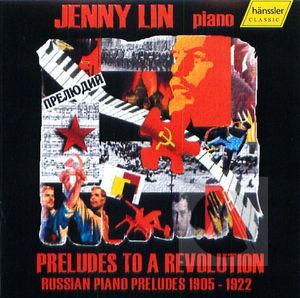
Preludes to a Revolution
produced by Rita Hermeyer; performed by Jenny Lin, fl. 1980 (Hänssler Classic), 1 hour 19 mins
Details
- Field of Interest
- Classical Music
- Content Type
- Music recording
- Duration
- 1 hour 19 mins
- Recording Engineer
- Rita Hermeyer
- Format
- Audio
- Sub Genre
- Prelude, Piece
- Label
- Hänssler Classic
- Performer
- Jenny Lin, fl. 1980
- Producer
- Rita Hermeyer
- Date Recorded
- 2004-09-01
- Review
- The premise implied by the title and chronological programming of this disc, Preludes to a Revolution -- that the sound of Russian piano music in the early twentieth century is connected to the political history of the country at the time -- does not necessarily hold up under close scrutiny. In fact, the liner notes talk more about the influences of the selected composers on each other than they do about any possible relation to historical events, although there is an interesting timeline included that matches historical events with events in the composers' lives. Regardless, the music is an intriguing snapshot of a particular form at a particular time in a particular place, combining examples from unknown composers with those of more recognizable names. The disc begins with single preludes by Lyadov (very much like Chopin's writing) and Glière representing the traditional Romantic, tonal prelude. It then moves on to mostly sets of preludes that explore tonality as a means of furthering the emotion of each work. Jenny Lin quite impressively brings out the sheer concentration of expression found in such brief moments. Stanchinsky's preludes range from yearning melancholy to bittersweet opulence. His 1908 single prelude is happier; staccato playing combines with colorful pedaling to produce a feeling of dappled sunlight. Stanchinsky and Lourié's preludes are still close traditional tonality, whereas the sets by Alexandrov and Obouhov are closer to Scriabin's use of multiple tonalities. The strong sense of mysticism in Obouhov's Prayers is like a small-scale foreshadowing of the music of Messiaen. The two preludes by Vishnegradsky are little dramas. The first has focusing dissonances that increase the tension of the mood, while the second is a grim, almost martial piece. Feinberg's preludes have a telescoping sense, either with outer quiet sections that build to a larger central section or outer grandeur that shrinks to the center. Roslavets' tonality goes a step beyond Scriabin, and his set has a more consistent sound between preludes than any of the other sets here. Lin knows her way around these pieces, playing not only with a sensitivity to the moods of the music, but also a confidence to carry her easily through the more technical challenges. The recording's sound is also quite good, allowing both the quiet moments to be intimate and the louder passages to be grand without overpowering the listener. ~ Patsy Morita, All Music Guide
- Subject
- Classical Music, Music & Performing Arts, Late Romantic, 20th Century, Romantismo Tardio, Romanticismo Tardío, Siglo XX, Século XX
- Keywords and Translated Subjects
- Romantismo Tardio, Romanticismo Tardío, Siglo XX, Século XX
